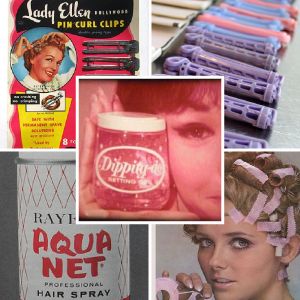My first job, not in a farm setting, was — shampoo girl. The salon, simply named Marie’s, was in a house located a few blocks away from my high school. Patrons would walk up the driveway, tap on the side door and let themselves in. A little bell hung above the entrance to announce their arrival.
I recall the earliest haircuts with me sitting on a board Marie laid across the armrests of her chair. She was the only person to cut my hair until I reached my early teens. She was a kind lady and I felt very at home at working there. The salon was a dark paneled room with one sink for washing hair, two work stations and three hair dryers. Her business was about people and service, not pizzazz, and everyone was fond of her.
When I think of that time, I hear women’s laughter and the hum of hairdryers. I smell permanent wave solution and cigarette smoke. A heavy glass ashtray adorned every surface. No one had heard of no-smoking laws, and we did, after all, live in a tobacco farming community. I am grateful to my younger self for not adopting the habit like so many of my contemporaries.

My job was straight forward: wash hair; sweep floors; pass curlers and pins, perm rods and papers. There was a large pedestal tray on wheels that was stocked with curlers of differing sizes, arranged by colour. The curler pins were stored, heads at one end of the tray compartment and points at the other.
When Marie was doing a set, I’d pass the correct curler followed by a pin. I imagined that it was like being a surgical nurse. I anticipated what she’d need without her uttering so much as a word, by watching the pattern of curlers and other clues that bloomed as she worked. While the tail of her comb traced out another tidy rectangle in her patron’s hair, I’d hold the next curler or hairpin in midair, ready to place the item in Marie’s palm.

Beauty came at a price for the fiscally conscious who did their hair at home. Drying time was a big factor; wet hair twisted around a curler takes a long time to air dry. Some ladies hastened this process with portable hair dryers like the one shown below. I myself have been the victim of this contraption and remember well the tops of my ears feeling aflame. The restricted range allowed by a length of electrical cord proved inconvenient during the drying time which may have lasted up to an hour.
Most ladies washed and set their hair at bedtime, so their curls could dry overnight. Imagine the discomfort of the spiky curler bristles and plastic pins pressing into their scalps when their heads laid on the pillow. I remember my grandmother’s joy at the advent of plastic clip in curlers and ultimately the foam curlers that spared her this test of endurance. Not everyone was willing to contend with the overnight pain. A lady wearing curlers under a black or pink chiffon head scarf was a common sight at the grocery store.

It has been such fun to revisit bouffant hairstyles, backcombing and beehives, but there is a larger purpose behind my stroll down memory lane. My novel The Last Hoffman spans the 1950s to 1980s. The narrative required a hub for the exchange of community news much like the weekly visit to the general store or the post office in days gone by. Because of my experience, I recognized the small town salon as a perfect device for this purpose.
A number of ladies had a standing appointment for the same day and time each week, year in and year out. This practice provides me with a delicious opportunity to dream up fascinating local characters and maybe — a little trouble — to keep things interesting.
Lead photo: by photographer Ida Wyman/ Madison Museum of Contemporary Art
Photo sources for collaged images and additional images can be found by clicking: “Salon” .
(PS Thanks for stopping by. Click here to receive Chapter 1 of Gwen’s debut novel The Last Hoffman, and a monthly-ish email summary of news and recent posts.)

Sacrifice, betrayal, family secrets! A widower and young mother struggle to overcome their tragic pasts in a dying mill town. The Last Hoffman is the story of a quiet man who is tested and discovers his courage. It will restore your belief in second chances.
“For all the novel features characters that are alone, it is a story driven by human connections (…) With vivid descriptions, natural dialogue and in-depth characterization, Tuinman compels us to look beyond the surface. The ending is triumphant!” –Gail Murray, Historical Novel Society



May 20, 2014 at 2:45 pm
This is a great piece, Gwen. I can see the salon. My mother always goes to salons like this. I had long hair for a really long time and so rarely did anything but trim it and wear it in a bun, and one very very bad experience with a perm when I was about fourteen convinced me to never do anything involving chemicals to my hair ever again. 🙂 Now I wear my hair in a short bob or even shorter so that I can again not fuss with it. I’ve always been sporty so that feels natural to me. That said, I have known many elderly ladies who had standing appointments to have their hair done, and here in Italy my partner often comments something to the effect of, “Look at that signora who just had a permanente done.” The elderly ladies here leave the house in perfect suits and scarves, handbags, shiny shoes and pearls and even furs in winter, just as I remember my grandmother doing in the 1970s. And of course, their hair is perfectly tinted and coiffed. I think it’s very dignified and special. Good luck with the fiction piece.
May 20, 2014 at 4:34 pm
I so enjoyed reading your comment. I too suffered a perm nightmare. And wasn’t a perm just the worst when it was growing out — straight at the scalp and curly on the ends. What were we thinking? I had such an image in my mind when you described the signora who just had a permanente done. Your comment was a gift:) Thank you for the well wishes for my writing also. Take good care.
May 20, 2014 at 9:28 pm
Your post brought back such delicious memories of hair styling, curlers and those horrific hairdryers that practically burned your skull. I remember sleeping with those prickly rollers on my head. And the scotch tape and the smell of permanent solution that took days to get out.
One of my friend’s mother had a hair salon in her back yard and when it was closed we’d often go in it and play hairdresser. I haven’t thought about this in ages.
What a wonderful subject for a novel. There’s so much “history” in it. And lots of opportunity for trouble. It must be fun to write. Good luck with it. 🙂
May 21, 2014 at 6:35 am
Carol, so great to hear from you. I enjoyed reading about your friend’s mother’s salon in the backyard. It must have been a lot of fun for you girls to play there. Capes. Clips. Hair teased up. Sounds like good fun!
May 21, 2014 at 4:54 pm
Great post Gwen – my mother had one of those hairdryers and I did use it now and then when I was little – seeing that picture brings back the memory of it – I can remember the sound and the sensation of it on my head!
May 22, 2014 at 8:13 am
Isn’t funny how those specific details come back to us? I think the occasions when I suffered through the time under the drier, involved preparations for a Sunday school Christmas pageant. I thought the tops of my ears would burst into flame. When the drier cap finally came off, I remember that the curlers had to stay in until the hair cooled down. Oh my, it was a big time commitment:)
May 27, 2014 at 6:50 am
Hi there! This is kind of off topic but I need some advice from an established blog.
Is it difficult to set up your own blog?
I’m not very techincal but I can figure things
out pretty quick. I’m thinking about creating
my own but I’m not sure where to begin. Do you
have any ideas or suggestions? Appreciate it
May 27, 2014 at 7:15 am
Hi Jumi .. So glad you dropped by. I messaged you on Facebook with a few suggestions. Enjoy the journey:) I look forward to visiting your blog soon. All the best.
November 12, 2015 at 9:49 pm
i remember as a child watching my late mother set her hair on rollers before sitting under her ronson escort softhood dryer, I would watch with great entrigue and fascination wishing it was me in the rollers under the dryer so at 15 I would visit hair salons for a conditioning treatment so that I could experience sitting under a dryer , at 16 I got my first perm then at 26 I finally took the plunge to get my first shampoo and set , now 20 years on I still get my hair permed coloured and set on a regular basis and I am not phased by it in any way. In fact I love the whole salon experience.
Thanks mum for making me the person I am today.
R.I.P. Mum
March 20, 2016 at 5:33 pm
What a lovely remembrance, Lance. It’s heart warming that this process connects you to the memory of your mother. Thank you so much for writing.
March 13, 2016 at 7:38 pm
I sleep in curlers almost every night…just luv it
March 20, 2016 at 5:34 pm
Do you use foam curlers, Bonnie? I remember wearing the black mesh curlers with the bristles and getting such a headache.
March 21, 2016 at 11:55 am
Hi Gwen…I sleep almost every night in 44 pink velcros…mohawk pattern…with a hairnet and scarf..I am a male(CD) who has had a huge curler fetish since I was a little boy
March 21, 2016 at 6:50 pm
If only I had your patience. My hair has developed a natural wave so I usually let it air dry. You’ve inspired me to give my curlers a whirl again. I am so glad you wrote and thank you for sharing:)
June 24, 2016 at 6:06 am
Gwen, this is so what it was like! And I remember when we got the first hair dryer at home. It was actually my mother’s but I got to use it first. How exciting. And now, how awful it seems. Times change, don’t they?
June 29, 2016 at 4:16 pm
They really do, Elaine. I remember on highschool, the hours I spent with a curling iron and my arms held over my head. Now days, I let my hair dry naturally. I much prefer this way! So great to hear from you. By the way, your site looks wonderful.
September 16, 2017 at 3:26 pm
I loved this story! I remember my Grandmother still in her 80’s went every week to get her hair washed and set. She loved her stylist like a dear friend. Those relationships are so good for the soul… women need to connect more on this level I believe. thank you for writing this!
September 17, 2017 at 12:43 pm
Thank you, Cheryl, for that lovely anecdote. In my novel, The Last Hoffman, the salon is the hub of news and sometimes gossip for the women in the small town in which the story is set. As a young girl, it was always a treat to hover at the edge of the women’s conversations. So glad you enjoyed the nostalgia.